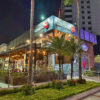Cave and Basin National Historic Site is considered the birthplace of the national park system in Canada when three opportunistic railway workers stumbled upon a cave full of hot mineral spring waters and noticed the vent leading to a large cavern full of warm water in November of 1883 in what is now known as Banff National Park — which is the first national park established in Canada — and the rest is history.
Why Cave and Basin National Historic Site in Banff Was Not My Favorite Place to Visit

Cave and Basin National Historic Site is a part of the Rocky Mountain Parks World Heritage Site of the United Nations Educational, Scientific and Cultural Organization — which is otherwise more popularly known as UNESCO.

The entrance to the site reflects those pioneering days — complete with an old pickup truck and the Union Jack flag of the United Kingdom flapping in the breeze.

Visitors are treated to views of the surrounding mountains once they pass the entrance. The mountain covered with snow at its peak is Cory Mountain; and to the right of it is Mount Norquay, from which I was treated to breathtaking views of the valley in which the town of Banff is located. Pilot Mountain is at the extreme left of the above photograph.

This spot marks the birthplace of the national park system in Canada and the beginning of modern Banff — as well as the site of the first hotel property in Banff.

Once “inside”, the sign on the left imparts the story of William McCardell, Tom McCardell and their friend Frank McCabe — who are the aforementioned three opportunistic railway workers — who spent two or three days constructing a rough log shack next to the cave vent hole which they discovered. In 1885 through 1886, William McCardell lived in this shack for a year or two in order to protect the claim that the three men had filed with the government for the hot springs.
When archaeologists excavated the site in 1982, all that remained of the building was a three-sided berm, floorboards and sill logs. Many small objects were also found at the site — such as a dime from 1886; a pen knife; a pair of scissors; two spoons; and spent rifle cartridges.

This is a photograph of the cave vent hole which the three men discovered. It is now protected by a grating.

This thermal spring is extremely fragile and is home to the Banff springs snail, which is an endangered species. A sign warns that disturbance of this spring in any way is prohibited.

A narrow stream of mineral water flows past sediment left on rocks.

Pools of mineral water are found at the site amongst the scenic views of the surrounding mountains…

…including this vividly green pool of water…

…and a closer view reveals that this green water is bubbling — indicating that it is a thermal spring.

Algae is amongst what can be viewed from the Discovery Boardwalk Trail, which is approximately two-fifths of a kilometer in length; and other than some steps, it is a very easy trail on which to walk.

This view is from the highest point of the boardwalk at Cave and Basin National Historic Site. The mock hotel facade and the cave vent hole surrounded by the boardwalk are shown at the bottom right part of the above photograph, framed in the background by Cory Mountain and Mount Norquay.
Summary
I enjoyed being at the historic spot which is considered to be the birthplace of the national parks system of Canada and Banff National Park; but the other activities offered at Cave and Basin National Historic Site simply did not interest me. I have seen plenty of thermal pools and fumeroles at places such as Yellowstone National Park in the United States and Waiotapu Thermal Wonderland in New Zealand; and I have been in numerous caves such as Carlsbad Caverns National Park and Mammoth Cave National Park in the United States — so the activities and features offered by Cave and Basin National Historic Site were not as appealing to me as what many other areas of Banff National Park had to offer. That, of course, does not mean that you should not visit — especially if you have not yet visited the sites around the world which I have already visited.
Cave and Basin National Historic Site — which is located at 311 Cave Avenue in Banff, Alberta T0L 0C0 and is very easy to find due to plenty of directional signage — is included with admission into Banff National Park, which is free of charge for the remainder of 2017. It is open daily between the hours of 9:00 in the morning to 5:00 in the afternoon through Sunday, October 15, 2017; and between Monday, October 16, 2017 through Sunday, December 31, 2017, it is open to the public Wednesdays through Sundays from 11:00 in the morning to 5:00 in the afternoon.
All photographs ©2017 by Brian Cohen.

